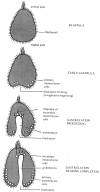A novel approach to study adhesion mechanisms by isolation of the interacting system
- PMID: 16181663
- PMCID: PMC1857332
- DOI: 10.1016/j.acthis.2005.06.009
A novel approach to study adhesion mechanisms by isolation of the interacting system
Abstract
For decades most investigations into mechanisms of adhesive interactions have examined whole organisms or single cells. Results using whole organisms are often unclear because it may not be known if a probe used in an experiment is directly affecting the cellular interaction under study or if it is an indirect effect resulting from action on some other structure or pathway. Here we develop a novel approach to isolate the structural components of a cellular interaction by dissecting them out of the organism to study them in a pristine environment away from all confounding factors. We used the adhesion between the archenteron and blastocoel roof of the sea urchin gastrula stage embryo as a model that can be replicated in many other developmental and pathological systems. The isolated components of the cellular interaction and those in the whole organism possessed identical cell surface receptors and adhesive affinities.
Figures




Similar articles
-
Hyalin is a cell adhesion molecule involved in mediating archenteron-blastocoel roof attachment.Acta Histochem. 2008;110(4):265-75. doi: 10.1016/j.acthis.2007.11.004. Epub 2008 Feb 8. Acta Histochem. 2008. PMID: 18262230 Free PMC article.
-
Carbohydrate involvement in cellular interactions in sea urchin gastrulation.Acta Histochem. 2004;106(2):97-106. doi: 10.1016/j.acthis.2004.01.001. Acta Histochem. 2004. PMID: 15147630
-
A role for polyglucans in a model sea urchin embryo cellular interaction.Zygote. 2014 Aug;22(3):419-29. doi: 10.1017/S0967199413000038. Epub 2013 Mar 27. Zygote. 2014. PMID: 23534855
-
Gastrulation in the sea urchin.Curr Top Dev Biol. 2020;136:195-218. doi: 10.1016/bs.ctdb.2019.08.004. Epub 2019 Oct 22. Curr Top Dev Biol. 2020. PMID: 31959288 Free PMC article. Review.
-
Isolation of organelles and components from sea urchin eggs and embryos.Methods Cell Biol. 2004;74:491-522. doi: 10.1016/s0091-679x(04)74020-0. Methods Cell Biol. 2004. PMID: 15575619 Review. No abstract available.
Cited by
-
Exogenous hyalin and sea urchin gastrulation. Part IV: a direct adhesion assay - progress in identifying hyalin's active sites.Zygote. 2010 Feb;18(1):17-26. doi: 10.1017/S0967199409005498. Epub 2009 Jun 8. Zygote. 2010. PMID: 19500445 Free PMC article.
-
Exogenous hyalin and sea urchin gastrulation, Part II: hyalin, an interspecies cell adhesion molecule.Zygote. 2008 Feb;16(1):73-8. doi: 10.1017/S0967199407004546. Zygote. 2008. PMID: 18221584 Free PMC article.
-
Exogenous hyalin and sea urchin gastrulation. Part III: biological activity of hyalin isolated from Lytechinus pictus embryos.Zygote. 2008 Nov;16(4):355-61. doi: 10.1017/S096719940800484X. Epub 2008 Oct 17. Zygote. 2008. PMID: 18925979 Free PMC article.
-
Carbohydrate-based experimental therapeutics for cancer, HIV/AIDS and other diseases.Acta Histochem. 2008;110(1):6-13. doi: 10.1016/j.acthis.2007.08.003. Epub 2007 Oct 25. Acta Histochem. 2008. PMID: 17963823 Free PMC article. Review.
-
Hyalin is a cell adhesion molecule involved in mediating archenteron-blastocoel roof attachment.Acta Histochem. 2008;110(4):265-75. doi: 10.1016/j.acthis.2007.11.004. Epub 2008 Feb 8. Acta Histochem. 2008. PMID: 18262230 Free PMC article.
References
-
- Alliegro MC, Alliegro MA. The structure and activities of echinonectin: a developmentally regulated cell adhesion glycoprotein with galactose-specific lectin activity. Glycobiology. 1991;1:253–256. - PubMed
-
- Akasaka K, Amemiya S, Terayama H. Scanning electron microscopical study of the inside of sea urchin (Pseudocentrotus depressus): effects of aryl beta-xyloside, tunicamycin and deprivation of sulfate ions. Exp Cell Res. 1980;129:1–13. - PubMed
-
- Angerer LM, Angerer RC. Patterning the sea urchin embryo; gene regulatory networks, signaling pathways and cellular interactions. Curr Top Dev Biol. 2003;53:159–198. - PubMed
-
- Asao MI, Oppenheimer S. Inhibition of cell aggregation by specific carbohydrates. Exp Cell Res. 1970;120:149–157. - PubMed
Publication types
MeSH terms
Substances
Grants and funding
LinkOut - more resources
Full Text Sources
Miscellaneous

